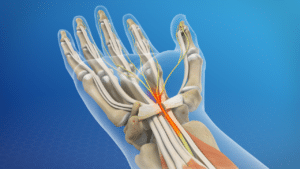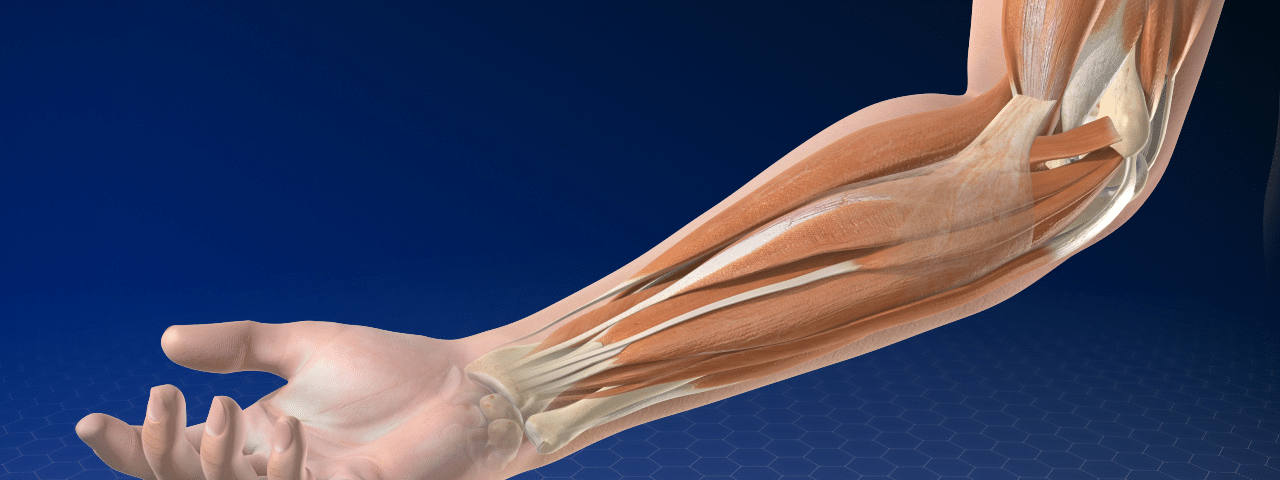Surgical Hand & Wrist Treatments
From large, complex orthopaedic surgeries to the intricate details of the hand and wrist, our team specializes in reconstruction and microsurgery procedures involving vessels so small that we require special magnifying equipment just to see them.
Carpal Tunnel Release
Carpal tunnel syndrome manifests as numbness, tingling, weakness, and related issues in the hand due to pressure on the median nerve in the wrist. This nerve, along with several tendons, passes from the forearm to the hand through a narrow space known as the carpal tunnel. Responsible for movement and sensation in the thumb and first three fingers (excluding the little finger), the median nerve is affected by pressure within the carpal tunnel. This pressure can arise from swelling or any factor reducing the tunnel’s size. The surgical solution involves releasing a ligament at the base of the hand to alleviate pressure on the median nerve.

Immediately after surgery, a bulky dressing will be applied to your hand and wrist to minimize postoperative swelling. Keep the dressing clean and dry, and avoid soaking the incision in water. The dressing can be removed after 1 day, and the incision can be gently cleaned with soap and water. Replace the dressing with a clean one, such as a band-aid, and change it daily or as needed for any bleeding or drainage.
Inspect the incision daily for any abnormal drainage or excessive bleeding, and report any concerns to your healthcare provider promptly.
Hand therapy will be scheduled approximately one week after surgery to remove sutures and initiate range of motion exercises. Scar massage may also be started at this time. Typically, you’ll attend 1-3 therapy sessions to ensure optimal motion and function recovery.
To manage postoperative pain and swelling, elevate your hand above your heart and perform gentle hand exercises after removing the bulky dressing. Avoid heavy lifting or activity until after your hand therapy follow-up appointment.
You’ll be prescribed a narcotic pain medication, which should be taken as directed to manage pain effectively. Consider using over-the-counter stool softeners to prevent constipation, as narcotics can cause this issue. Ice packs wrapped in a towel can be applied to the surgical area for pain relief, with 20-30 minutes between applications.
Do not drive while taking narcotic pain medication and ensure you feel strong and alert before driving.
Contact your therapist or surgeon immediately if you experience fever above 101°F, new or abnormal drainage from the incision, or chest pain or shortness of breath.
Limit lifting to no more than 5 pounds for the first 2 weeks post-surgery to minimize swelling. After 2 weeks, gradually resume activities as tolerated, avoiding repetitive hand movements and heavy tasks. You can gradually increase activity level after 4 weeks, including tasks like vacuuming, mowing the lawn, and gardening.
CMC Arthroplasty
The surgery to alleviate thumb pain caused by arthritis involves removing the arthritic bone responsible for the pain. The surgeon then constructs a support to preserve the thumb’s length, and the body utilizes scar tissue to establish a stable base for the thumb. Progressive thumb motion is permitted over the course of several weeks.

During your surgery, your surgeon removes a small bone, the trapezium, at the base of the thumb. The procedure also involves constructing support with surrounding soft tissue structures to maintain proper thumb function. These structures require healing time, with the goal of reducing thumb pain post-healing. Typically, a post-operative dressing that supports the wrist and thumb is worn for 2 weeks. Weekly hand therapy commences 2 weeks after surgery. Most patients commonly take at least 1-2 weeks off work and then transition to restricted duty for 2-3 months, initially with limitations such as no pinching, light finger use, no lifting over 1 pound, and wearing a cast or splint for 2-3 months.
During the first week after surgery, you can minimize swelling by elevating your arm above your heart as much as possible. Finger exercises are also recommended to reduce swelling and maintain finger flexibility.
In therapy, you’ll learn safe movements and functional use of your thumb.
Around 2 weeks post-surgery, you’ll visit your surgeon and hand therapist to have a forearm-based thumb splint made. You’ll be allowed to shower without the splint, but soaking the hand is not advised. Finger exercises and scar massage will continue, as scar tissue is crucial for stabilizing the thumb base during healing.
Between weeks 3-5, pain and swelling management are still necessary, with thumb exercises added gradually. Avoid combining wrist and thumb bending, and refrain from forcefully pressing your palm and thumb flat on a surface. A scar pad may be provided for nighttime use with the splint. At approximately 5 weeks post-surgery, wrist motion will be incorporated into your home program.
Around week 6, you’ll start using your thumb for daily tasks like dressing, eating, and light housework, but avoid stressing the thumb by attempting to flatten your palm on a table.
Between weeks 8-10, a plastic splint will be used for activities involving forceful pinching/gripping. You’ll also be introduced to thumb stability exercises, joint protection techniques, and may require a neoprene thumb splint for additional joint protection. Gentle hand strengthening exercises may be initiated as needed. Therapy typically concludes around 10-12 weeks post-surgery, although hand function will continue to improve for several months.
Nerve Decompressions
The radial nerve, ulnar nerve, and median nerve can become compressed in the elbow and forearm area. If surgical release is necessary, the surgeon will make an incision at the site of nerve compression. The nerve is then decompressed, and the limb is manipulated to ensure free movement of the nerve. Short-term hand therapy is often recommended after surgery to learn nerve gliding exercises and manage scar tissue formation.
Dupuytren’s Contracture Release
The diseased palmar fascia, bands, and nodules that cause the fingers to curl into the palm are removed. The affected fingers are splinted straight, with the splint worn at night for up to 3 months. Both surgical techniques and non-surgical injections can manage hand contracture.
Tendon Repair
Severed tendons of the hand and fingers need to be repaired for proper movement.
Mucous Cyst Excision & Ganglion Excision
Cysts at the wrist area or the finger can be painful and interfere with function. When this occurs, surgery may be recommended.
Fracture Stabilization
Fractures of the arm, wrist, hand, and fingers can result in poor alignment or instability. These conditions may lead to bones healing in a position unsuitable for function or may fail to heal altogether, resulting in pain and impaired function. If your fracture indicates a potential for poor functional outcome, a surgeon will discuss surgical stabilization with you. They will explain the risks and benefits of surgery as they relate to your fracture and your future hand function needs and goals.
Joint Fusions
At times, painful joints may severely limit function, necessitating consideration of joint fusion. During this procedure, the joint is stabilized to allow it to heal together, resulting in the elimination of motion and joint pain. Joint fusion can sometimes lead to improved hand function. A surgeon will discuss the benefits and drawbacks of joint fusion as part of the consideration process.
De Quervain’s Release
This is inflammation of two tendons within a single sheath located at the base of the thumb. Treatment options may include a wrist-thumb brace, thumb injection, or, if necessary, surgery. Surgical intervention involves opening the sheath to create more space for the two tendons to slide and move freely as the thumb and wrist move.
Trigger Ringer Release
At times, a finger can become trapped in the pulley system that holds tendons near the bones of the finger, resulting in difficulty straightening the finger. Treatment options may include splinting, icing, cortisone injection, or surgery to release the pulley, allowing the tendons to move freely.

